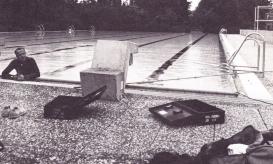My research project examines the electronic circuit as a technological, artistic, and social medium that interconnects disparate histories of postwar art, music, and media. The project continues my research on American experimental musician, sonic artist, and electronic engineer Max Neuhaus (1939–2009), who explored the electronic circuit as a “post-musical” platform to create the hybridized artistic practice of sound installation. Neuhaus’s sound installations, such as the continuous resonant drone of Times Square (1977) or the listener-generated, and self-modulating, radio network Radio Net (1977), expanded artistic and cultural boundaries by constructing immersive public sonic environments and virtual spaces, 1960–1980, that evaded conventions of musical performance, composition, and spectatorship.
At the MPIWG, I will research Neuhaus’s activities in West Germany, 1976–1977, encompassing his DAAD artist residency and creation of underwater sound installations in public swimming pools. Collectively known as Underwater Music, these works were among Neuhaus’s earliest experiments with the electronic circuit to create continuous, immersive sonic environments. I will analyze the technological, artistic, and cultural forces that supported Neuhaus’s experiments in underwater sound generation and perception, including the artist’s unexpected connections to the American corporate and militaristic ambitions of Bell Labs and the U.S. Navy’s Underwater Sound Reference Division (USRD), in addition to the public radio stations Rundfunk im amerikanischen Sektor (RIAS) and Radio Bremen. My research provides a naturally interdisciplinary frame for contextualizing Neuhaus’s emergent sound installation practice as circumscribed by conflicts between new music, sonic art, public space, acoustical engineering, and the geopolitics of listening.

